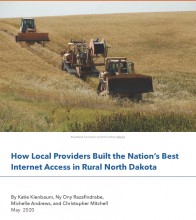How Local Providers Built the Nation’s Best Internet Access in Rural North Dakota

Contrary to the common narrative of poor connectivity and dim prospects for rural America, the vast majority of rural North Dakotans have gigabit fiber Internet access available to them today.
Our case study, How Local Providers Built the Nation’s Best Internet Access in Rural North Dakota, explains how this came to be, highlighting how 15 telephone cooperatives and local companies came together to invest in their rural communities and build fiber broadband networks across the state. In the 1990s, those companies united to purchase 68 rural telephone exchanges in North Dakota from regional provider US West (now CenturyLink). Then, they leveraged federal broadband funds to deploy some of the most extensive fiber networks in the country, turning North Dakota into the rural broadband oasis that it is today.
Download the case study, How Local Providers Built the Nation’s Best Internet Access in Rural North Dakota [pdf].
A Model for Better Rural Connectivity
The case study explores North Dakota's exceptional rural connectivity through several maps and graphs and offers the following takeaways:
- 15 local telephone companies and cooperatives took advantage of regional monopoly US West's failure to view its rural properties as profitable and acquired 68 of the provider's exchanges in rural North Dakota, creating the foundation for fiber networks that would one day crisscross the state.
- More than three quarters of rural North Dakotans have access to fiber broadband today, compared to only 20 percent of rural residents nationally. Over 80 percent of North Dakota's expanse is covered by fiber networks.
- National telecom monopolies refuse to substantially upgrade their rural networks even though they receive billions in subsidies, while local co-ops and companies continue to invest in their communities — proving the solutions for better rural connectivity already exist.
Read How Local Providers Built the Nation’s Best Internet Access in Rural North Dakota [pdf].



